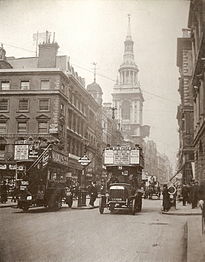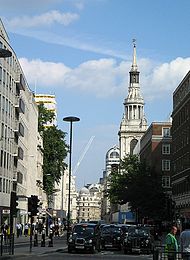Cheapsideis a street in theCity of London,the historic and modern financial centre ofLondon,England, which forms part of theA40 London to Fishguard road.It linksSt Martin's Le GrandwithPoultry.Near its eastern end atBank Junction,where it becomes Poultry, isMansion House,theBank of England,andBank station.To the west isSt Paul's Cathedral,St Paul's tube stationand square.
In theMiddle Ages,it was known as Westcheap, as opposed toEastcheap,another street in the City, nearLondon Bridge.The boundaries of thewardsofCheap,CordwainerandBread Streetrun along Cheapside and Poultry; prior to boundary changes in 2003 the road was divided amongstFarringdon WithinandCripplegatewards[1]in addition to the current three.
The contemporary Cheapside is the location of a range of retail and food outlets and offices, as well as the City's only major shopping centre,One New Change.
Etymology and usage
editCheapsideis a common English street name, meaning "market place", fromOld Englishceapan,"to buy" (cf. Germankaufen,Dutchkopen,Danishkøbe,Norwegiankjøpe,Swedishköpa), whence alsochapmanandchapbook.[2]There was originally no connection to the modern meaning ofcheap( "low-priced" or "low-quality", a shortening ofgood ceap,"good buy" ), though by the 18th century this association may have begun to be inferred.
Other cities and towns in England that have a Cheapside includeAmbleside,Ascot,Barnsley,Birmingham,Blackpool,Bradford,Brighton,Bristol,Derby,Halifax,Hanley,Knaresborough,Lancaster,Leicester,Liverpool,Luton,Manchester,Nottingham,Preston,Reading,Settle,WakefieldandWolverhampton.There is also a Cheapside inBridgetown,Barbados;Le xing ton, Kentucky,US;Greenfield, Massachusetts,US;Saint Helier,Jersey; andLondon, Ontario,Canada.
History
editCheapside is the former site of one of the principalproduce marketsin London,cheapbroadly meaning "market" in medieval English. Many of the streets feeding into the main thoroughfare are named after the produce that was once sold in those areas of the market, including Honey Lane, Milk Street,Bread StreetandPoultry.
In medieval times, the royal processional route from theTower of Londonto thePalace of Westminsterwould include Cheapside. During state occasions such as the first entry ofMargaret of France(second wife ofKing Edward I), into London in September 1299, the conduits of Cheapside customarily flowed with wine.[3]
During the reign ofEdward IIIin the 14th century, tournaments were held in adjacent fields. The dangers were, however, not limited to the participants: a wooden stand built to accommodateQueen Philippaand her companions collapsed during a tournament to celebrate the birth of theBlack Princein 1330. No one died, but the King was greatly displeased, and the stand's builders would have been put to death but for the Queen's intercession.
In the early 1300s one of the armourers working in the area wasAlice la Haubergere,who owned an armour shop and made her role within the occupation part of her identity, which was unusual for the period.[4]
On the day preceding her coronation, in January 1559,Elizabeth Ipassed through a number of London streets in a pre-coronation procession and was entertained by a number of pageants, including one in Cheapside.
Meat was brought in to Cheapside fromSmithfield market,just outsideNewgate.After the greatChurch of St Michael-le-Querne,the top end of the street broadened into adual carriagewayknown asthe Shambles(referring to an open-airslaughterhouseand meat market), with butcher shops on both sides and a dividing central area also containing butchers. Further down, on the right, was Goldsmiths Row, an area ofcommoditydealers.From the 14th century to theGreat Fire,the eastern end of Cheapside was the location of theGreat Conduit.
Literary connections
editCheapside was the birthplace of bothJohn MiltonandRobert Herrick.It was for a long time one of the most important streets in London. It is also the site of the 'Bow Bells', thechurch of St Mary-le-Bow,which has played a part in London'sCockneyheritage and the tale ofDick Whittington.Geoffrey Chaucergrew up around Cheapside and there are a scattering of references to the thoroughfare and its environs throughout his work. The first chapter ofPeter Ackroyd'sBrief Livesseries on Chaucer also colourfully describes the street at that time.[5]
William Shakespeareused Cheapside as the setting for several bawdy scenes inHenry IV, Part I.A reference to it is also made inHenry VI, Part II,in a speech by the rebelJack Cade:"all the realm shall be in common; and in Cheapside shall my palfrey go to grass".
Thomas Middleton's playA Chaste Maid in Cheapside(1613) both satirises and celebrates the citizens of the neighbourhood during the Renaissance, when the street hosted the city's goldsmiths.
William Wordsworth,in his 1797 poemThe Reverie of Poor Susan,imagines a naturalistic Cheapside of past:
And a river flows on through the vale of Cheapside.
Jane Austen,in her 1813 novelPride and Prejudice,characterises Cheapside as a London neighbourhood frowned upon by the landed elite:[6]
"I think I have heard you say that their uncle is an attorney in Meryton."
"Yes; and they have another, who lives somewhere near Cheapside."
"That is capital," added her sister, and they both laughed heartily.
"If they had uncles enough to fill all Cheapside," cried Bingley, "it would not make them one jot less agreeable."
"But it must very materially lessen their chance of marrying men of any consideration in the world," replied Darcy.
Charles Dickens Jr.wrote in his 1879 bookDickens's Dictionary of London:
Cheapside remains now what it was five centuries ago, the greatest thoroughfare in the City of London. Other localities have had their day, have risen, become fashionable, and have sunk into obscurity and neglect, but Cheapside has maintained its place, and may boast of being the busiest thoroughfare in the world, with the sole exception perhaps ofLondon-bridge.[7]
Hugh Lofting's bookDoctor Dolittle,published in 1951, names a quarrelsome London sparrow with a Cockney accent Cheapside. He lives most of the year in St Edmund's left ear in St Paul's Cathedral and is invited to the African country of Fantippo to deliver mail to cities because the other birds are not able to navigate city streets.
Cheapside is also depicted inRosemary Sutcliff's 1951 children's historical novelThe Armourer's House,along with other parts ofTudor London.
In a more contemporary treatment, the Cheapside of the Middle Ages was referenced in a derogatory sense in the 2001 movieA Knight's Taleas being the poor, unhealthy and low-class birthplace and home of the unlikely hero.
Nineteenth century Cheapside is presented as the home of Mary "Jacky" Faber inBloody JackbyL. A. Meyer.
Additionally, Cheapside is depicted as a major setting in the bestselling novel byMaria McCann,As Meat Loves Salt,a historical feature set against the English Civil War.[8]
William Gibson's mystery novelThe Peripheraldepicts a 22nd-century Cheapside converted to a Victorian-eracosplayzone where only 19th century costume is allowed.
Contemporary Cheapside
editCheapside today is a street of offices and developments of retail outlets. It can no longer be described as "the busiest thoroughfare in the world" (as in Charles Dickens, Jr.'s day) and is instead simply one of many routes connecting theEast Endand the City of London with theWest End.
Cheapside was extensively damaged duringThe Blitzin late 1940 and particularly during theSecond Great Fire of London.Much of the rebuilding following these raids occurred during the 1950s and 1960s and included a number of unsympathetic contemporary attempts at recreating the centuries-old architecture that had been destroyed. In recent years many of these buildings have themselves been demolished as a programme of regeneration takes place along Cheapside fromPaternoster SquaretoPoultry.
The draft Core Strategy of the City'sLocal Development Frameworksoutlines the vision and policies for the Cheapside area, aiming to increase the amount of retail space along and near the street, and make the area a good environment for visitors and shoppers. The plan is to re-establish the street as the City's "High Street", including as a weekend shopping destination (until recently many retail units in the City were closed on Saturday and Sunday).[9][10]A major retail and office development at the heart of the scheme,One New Change,opened 28 October 2010.[11]It is sited on Cheapside at the intersection with New Change, immediately to the east of St Paul's Cathedral.[12][13]
To address the anticipated rise in the number of shoppers as a result of the regeneration, the street itself has undergone reconstruction works to make the area more sympathetic to pedestrian traffic; the works are expected to make Cheapside the main shopping area in the City of London.
Cheapside formed part of themarathon courseof the2012 OlympicandParalympicGames. The women's Olympic marathon took place on 5 August and the men's Olympic marathon took place on 12 August. The four Paralympic marathons were held on 9 September.[14]
See also
editReferences
editSources
- A Glossary and Etymological Dictionary: Of Obsolete and Uncommon WordsWilliam Toone (Bennett: London, 1834)
- Kings and Queens of Britain,Williamson, D. (1986), Salem House,ISBN0-88162-213-3.
Endnotes
- ^'Cripplegate, one of the 26 Wards of the City of London'Baddesley, J.J.p. 50: London: Blades, East & Blades; 1921
- ^William Toone,A Glossary and Etymological Dictionary: Of Obsolete and Uncommon Words(Bennett: London, 1834)
- ^Williamson, D. (1986),Kings and Queens of Britain,p. 75, Salem House,ISBN0-88162-213-3.
- ^"The Women who Forged Medieval England | History Today".10 September 2024. Archived fromthe originalon 10 September 2024.Retrieved10 September2024.
- ^Ackroyd, Peter (2005).Chaucer(biography), chapter 1at Random House
- ^Austen, Jane (1813).Pride and Prejudice,chapter 8at Pemberley
- ^ Dickens, Charles Jr.(1879)."Cheapside".Dickens's Dictionary of London.Retrieved22 August2007.
- ^McCann, Maria (2001).As Meat Loves Salt.United Kingdom/Florida: Flamingo/Harcourt. pp.565.ISBN978-0-15-601226-3.
- ^City of London CorporationArchived12 June 2011 at theWayback Machinedraft Core Strategy, accessed July 2010
- ^City of London CorporationArchived13 June 2010 at theWayback MachineCheapside area improvements
- ^Thomas, Daniel (27 October 2010)."Retail centre gambles on Square Mile".Financial Times.Archivedfrom the original on 10 December 2022.Retrieved29 October2010.
- ^"One new change".onenewchange.
- ^InCheapsideArchived13 July 2011 at theWayback MachineOne New Change
- ^2012 London Olympics Men's Marathon: course mapArchived30 April 2013 at theWayback MachineandWomen's Marathon: course mapArchived2 May 2013 at theWayback Machine

